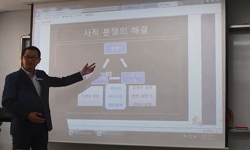Reconciliation in civil litigation can be called Alternative Dispute Resolution (ADR) in which a judge plays a role as an arbitrator from the viewpoint of the process of resolving disputes. In trying to draw out resolution in litigation, the court, wh...
http://chineseinput.net/에서 pinyin(병음)방식으로 중국어를 변환할 수 있습니다.
변환된 중국어를 복사하여 사용하시면 됩니다.
- 中文 을 입력하시려면 zhongwen을 입력하시고 space를누르시면됩니다.
- 北京 을 입력하시려면 beijing을 입력하시고 space를 누르시면 됩니다.

재판상화해의 활성화를 위한 법원의 적극적 역할 = The Positive Role of the Court to Promote and Revitalize Reconciliation in Civil Litigation
한글로보기부가정보
다국어 초록 (Multilingual Abstract)
Reconciliation in civil litigation can be called Alternative Dispute Resolution (ADR) in which a judge plays a role as an arbitrator from the viewpoint of the process of resolving disputes. In trying to draw out resolution in litigation, the court, which has a reconciliation proposal in its mind, provides a process for explanation and discussion with the parties to a suit or litigation representatives. As the judge, as a representative of public interests, would not hesitate to play a role as a guardian seeking to embody the spirit of the contemporary law in a concrete case, it is generally likely that the level of the judge's authority and participation is extremely high in drawing out the conclusion of reconciliation in litigation. The positive intervention of the court can be seen as an integral part in this model. As a result, this model should be required to safeguard the due process (procedure-guaranteeing) principle for the parties to a suit to the maximum level, considering that this model is not compatible with the original nature of the reconciliation system. The negative thoughts against the positive actions by the court to promote reconciliation in litigation are nothing but the preoccupation with the stereotype that even reconciliation in litigation should be reached by free agreement by the parties to a suit alone. The concrete legal standards can be drawn out as a consequence through the legal proceedings on the basis of disputed elements in the process of reaching a final agreement through mutual communication between the parties to a suit. Both judgment and reconciliation have an aspect of the formation of legal standards. The only difference between them is that the formation of legal standards by reconciliation is relatively more flexible. Reconciliation could be reached as a result of oral proceedings held between the conflicting parties in the legal proceedings, or any conclusion can be reached only after the court issues a ruling in some cases. They are identical to each other in that they are a kind of law-forming process through the legal proceedings. Owing to these characteristics, it is necessary that the court should establish a variety of aid measures, implement them and at the same time put some restrictions on the parties to a suit beyond existing practices that the court approves of the autonomous agreement on disputes between individuals and makes their agreement go into effect. The adjudication reconciliation of Japanese civil procedure law can be seen as a system which can be properly used for both the following cases: cases in which although the two sides have fulfilled their responsibilities for arguing and proving their positions, they want to leave concrete reconciliation to the court since both sides don't want to see their disputes settled by the court‘s black-and-while ruling; and cases in which although the two sides have fiercely carried out legal battles after selecting their own litigation representatives, its consequences cannot be predicted. In exercising discretion to recommend reconciliation of the Korean Civil Procedure Act, whose system is extremely similar to that of adjudication reconciliation of Japanese civil procedure law, it is necessary that the court should listen to the parties to a suit and introduce a system in which the two sides are required to vow in advance to accept the decision to recommend reconciliation by the court.
국문 초록 (Abstract)
소송상의 화해는 분쟁해결의 과정이라는 측면에서 보면 법관이 중개자로서의 역할을 하는 ADR이라고 할 수 있다. 소송상화해에서는 법원은 화해의 실체적·절차적 공정을 전제로 하여 사안�...
소송상의 화해는 분쟁해결의 과정이라는 측면에서 보면 법관이 중개자로서의 역할을 하는 ADR이라고 할 수 있다. 소송상화해에서는 법원은 화해의 실체적·절차적 공정을 전제로 하여 사안의 내용과 조화를 이루는 화해안을 염두에 두고 당사자나 소송대리인과 설명·협의를 진행한다. 법관은 공익의 대표자로서 그 시대의 법정신을 구체적인 사건에 구현하고자 하는 후견인적 역할을 마다하지 않을 것이므로 소송상화해의 결론을 도출하는 데 있어서도 법관의 권한이나 관여의 정도가 매우 높아지는 것이 일반적이다. 소송상화해의 촉진을 위하여 법원이 적극성을 발휘하는 데 대하여 부정적인 사고는 소송상화해의 경우에도 오로지 당사자들만의 자유로운 합의에 의한 것으로 보는 고정관념의 집착에 지나지 않는 것이다. 소송절차를 통하여 당사자의 상호소통에 의한 최종적 합의에 이르는 과정에서 분쟁사실을 기초로 하여 구체적인 법규범의 형성이라는 결과물이 도출될 수 있다. 판결이나 화해 모두 법규범의 형성이라는 측면을 가지고 있는 것이다. 그 차이라고 한다면 화해에 의한 법규범의 형성은 보다 탄력적 성격을 갖는 것으로 볼 수 있다. 소송절차에서 대립당사자 상호간의 변론(對席的辯論)이 진행된 결과로서 화해에 이를 수도 있을 것이고, 판결까지 가는 경우도 있는 것이다. 양자는 모두 소송절차를 통한 법형성 과정이라는 점에서 공통적 성격을 갖는 것이다. 이러한 특성으로 인하여 개인 간의 자율적 분쟁해결 합의에 대하여 법원이 승인하고 효력을 부여하는 것을 넘어서 법원이 다양한 지원방안을 마련하여 실시하면서 동시에 일정한 규제를 가하는 것도 필요하다. 일본민사소송법상 裁定和解는 쌍방의 당사자가 주장·입증책임을 다하였으나 법원의 一刀兩斷적인 판결에 의한 분쟁해결을 원하지 않는 분위기여서 구체적인 화해의 내용을 법원에 일임하고자 하는 경우나, 쌍방당사자 모두 소송대리인이 선임되어 치열한 법정다툼을 전개하였으나 그 결과를 예측할 수 없는 경우 등에 적절히 이용할만한 제도라 할 수 있다. 裁定和解와 제도상의 유사점이 많은 우리 민사소송법상의 화해권고결정을 운영함에 있어서 법원은 결정에 앞서 당사자의 의견을 청취하고, 당사자에게 미리 법원이 정하는 화해권고결정에 대하여 승복하기로 하는 약정을 하는 방식도 도입할 필요가 있을 것이다.
참고문헌 (Reference)
1 千種達夫, "離婚と和解(二・完)" (31) :
2 임상혁, "법원의 ADR" 한국민사소송법학회 12 (12): 33-47, 2008
3 이시윤, "민사소송법입문" 박영사 2016
4 함영주, "민사소송법상의 ADR 분류체계의 재검토– 절차혼용의 문제점과 관련하여 -" 한국민사소송법학회 17 (17): 515-554, 2013
5 법원행정처, "민사소송법개정내용해설"
6 호문혁, "민사소송법" 법문사 2016
7 유병현, "미국의 소송대체분쟁해결제도(ADR)의 현황과 그 도입방안" 한국민사소송법학회 13 (13): 490-524, 2009
8 河野正憲, "講座民事訴訟法Ⅱ" 弘文堂 1999
9 山田 文, "調停における私的自治の理念と調停者の役割" (47) :
10 草野芳郞, "訴訟上の和解について裁判官の和解觀の變遷とあるべき和解運營の摸索" (704) :
1 千種達夫, "離婚と和解(二・完)" (31) :
2 임상혁, "법원의 ADR" 한국민사소송법학회 12 (12): 33-47, 2008
3 이시윤, "민사소송법입문" 박영사 2016
4 함영주, "민사소송법상의 ADR 분류체계의 재검토– 절차혼용의 문제점과 관련하여 -" 한국민사소송법학회 17 (17): 515-554, 2013
5 법원행정처, "민사소송법개정내용해설"
6 호문혁, "민사소송법" 법문사 2016
7 유병현, "미국의 소송대체분쟁해결제도(ADR)의 현황과 그 도입방안" 한국민사소송법학회 13 (13): 490-524, 2009
8 河野正憲, "講座民事訴訟法Ⅱ" 弘文堂 1999
9 山田 文, "調停における私的自治の理念と調停者の役割" (47) :
10 草野芳郞, "訴訟上の和解について裁判官の和解觀の變遷とあるべき和解運營の摸索" (704) :
11 吉田元子, "裁判所等による和解條項の裁定とその範圍(二・完)" 43 (43):
12 垣內秀介, "裁判官による和解勸試の法的規律(硏究報告)" (49) :
13 垣內秀介, "裁判官による和解勸試の法的規律(1)" 117 (117):
14 高橋 裕, "現代社會におけるADRの役割(下)" 47 (47):
15 田中成明, "現代社會と裁判 - 民事訴訟の位置と役割" 弘文堂 1996
16 山本和彦, "決定內容における合意の問題-訴訟上の和解と裁判上の自白の手續的規制" (43) :
17 小松初男, "民事訴訟のスキルとマインド" 判例タイムズ社 2010
18 和田仁孝, "民事紛爭處理論" 信山出版社 1994
19 井上治典, "民事手續論" 有斐閣 1993
20 兼子 一, "條解民事訴訟法" 弘文堂 2011
21 吉田元子, "新民事訴訟法大系3卷" 靑林書院 1998
22 小林秀之, "新民事訴訟法の要點" 新日本法規 1996
23 硏究會, "新民事訴訟法-立法・解釋・運用"
24 이시윤, "新民事訴訟法" 박영사 2018
25 高橋 裕, "司法改革におけるADRの位置" 51 (51):
26 笹田榮司, "司法の新たな可能性?" 68 (68):
27 小山 昇, "仲裁の硏究(小山 昇 著作集(6)" 信山社 1991
28 芦部信喜, "人權と憲法訴訟" 有斐閣 1994
29 山田 文, "交涉と紛爭處理" 日本評論社 2002
30 和田仁孝, "井上治典追悼論文集 民事紛爭と手續 理論の現在" 法律文化社
31 法務省民事參事官室, "一問一答新民事訴訟法" 商社法務硏究會 1996
32 "ミニ・シンポジウム 訴訟手續における合意" (43) :
33 "シンポジウム民事訴訟への隣接科學の應用, ADR硏究からの訴訟上の和解への示唆" (63) :
34 Judith Resnik, "MANAGERIAL JUDGES" 96 : 1983
35 Jacqeline M. Nolan-Haley, "Informed Consent in Madiation : A Guiding Principle for Truly Educated Decision making" 74 : 1999
36 山田 文, "ADR硏究からの訴訟上の和解への示唆, シンポジウム民事訴訟への隣接科 學の應用" (63) :
37 垣內秀介, "ADRの基本的視座" 不磨書房 2004
38 早川吉尙, "ADRの基本 的視座" 不磨書房 2004
동일학술지(권/호) 다른 논문
-
경쟁법에서의 착취남용에 관한 연구 - 비교법적 방법을 중심으로 -
- 경북대학교 법학연구원
- 최요섭
- 2018
- KCI등재
-
- 경북대학교 법학연구원
- 박경규
- 2018
- KCI등재
-
- 경북대학교 법학연구원
- 남기연
- 2018
- KCI등재
-
리스본조약 이후 공동외교안보정책에 대한 EU 권한의 범위와 한계: 대북한 제한조치를 중심으로
- 경북대학교 법학연구원
- 채형복
- 2018
- KCI등재
분석정보
인용정보 인용지수 설명보기
학술지 이력
| 연월일 | 이력구분 | 이력상세 | 등재구분 |
|---|---|---|---|
| 2025 | 평가예정 | 재인증평가 신청대상 (재인증) | |
| 2022-01-01 | 평가 | 등재학술지 선정 (계속평가) |  |
| 2021-12-01 | 평가 | 등재후보로 하락 (재인증) |  |
| 2018-01-01 | 평가 | 등재학술지 유지 (등재유지) |  |
| 2016-02-12 | 학술지명변경 | 외국어명 : 미등록 -> KYUNGPOOK NATIONAL UNIVERSITY LAW JOURNAL |  |
| 2015-01-01 | 평가 | 등재학술지 유지 (등재유지) |  |
| 2011-01-01 | 평가 | 등재학술지 선정 (등재후보2차) |  |
| 2010-05-27 | 학회명변경 | 한글명 : 법학연구소 -> 법학연구원 |  |
| 2010-01-01 | 평가 | 등재후보 1차 PASS (등재후보1차) |  |
| 2008-01-01 | 평가 | 등재후보학술지 선정 (신규평가) |  |
학술지 인용정보
| 기준연도 | WOS-KCI 통합IF(2년) | KCIF(2년) | KCIF(3년) |
|---|---|---|---|
| 2016 | 0.73 | 0.73 | 0.82 |
| KCIF(4년) | KCIF(5년) | 중심성지수(3년) | 즉시성지수 |
| 0.79 | 0.8 | 0.912 | 0.34 |





 KCI
KCI




